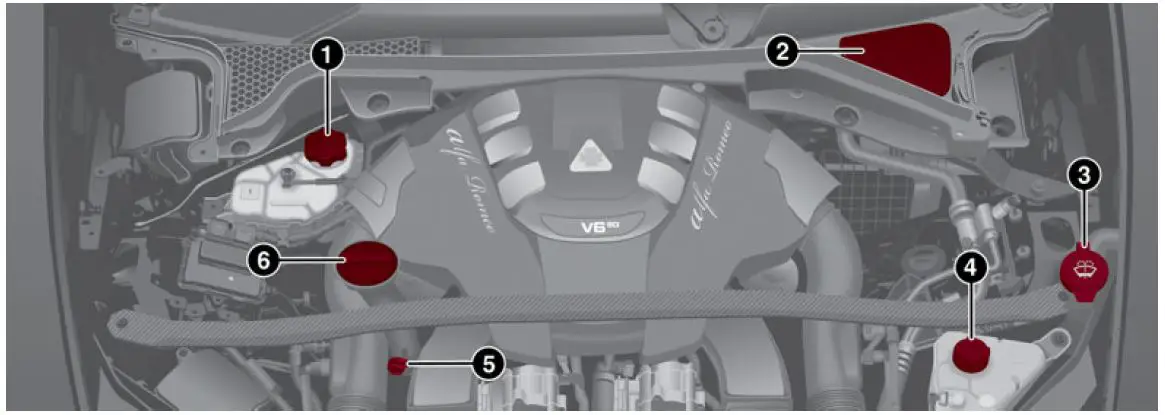2020 Alfa Romeo Stelvio Quadrifoglio Engine Oil and Fluids
In the 2020 Alfa Romeo Stelvio Quadrifoglio’s heart lies a technological marvel that makes it stand out as an incredibly high-performance SUV: an engine that was carefully designed and the oils and fluids that keep it running at their best. This 2.9-liter twin-turbocharged V6 engine is a work of automobile engineering perfection. It makes 505 horsepower and 443 lb-ft of torque, which is enough to speed the Stelvio Quadrifoglio from 0 to 60 mph in just 3.6 seconds. But it’s not just the engine’s raw power that makes it stand out; it’s also how well accuracy and performance work together. The engine oil is specially made to handle the high temperatures and pressures of fast driving. It keeps important parts lubricated and cool, and the transmission fluid and coolant work together to make shifting gears easier and keep the engine at the right temperature. These fluids keep the Stelvio Quadrifoglio alive, making sure that every drive is a symphony of power, speed, and excitement. It’s a great example of Alfa Romeo’s commitment to making great cars.
ENGINE COMPARTMENT
Checking Levels 2.9L V6 Engine

- Engine Coolant Reservoir Cap
- Brake Fluid Reservoir Cap Access Cover
- Windshield/Headlight Washer Fluid Reservoir Cap
- Intercooler Coolant Reservoir Cap
- Engine Oil Dipstick
- Engine Oil Filler
Engine Oil
The engine oil level can be seen on the instrument cluster display every time the engine is started, or on the Information and Entertainment system display by activating on the main menu (MENU button) the following functions in sequence:
- “Apps”
- “My Car”
- “Oil Level”
Check on the display using the 6 notches that the oil level is between the MIN and MAX level: 1 notch MIN level, 6 notches MAX level.
If the oil level is close to or below the MIN mark, add oil gradually through the filler,(refer to “Top-Up And Oil Level Indication Update On Display” in this section) considering that each notch shown on the display corresponds to approximately 8.8floz(250ml).
Caution
- Make sure not to add too much oil when topping off the engine. Engine oil in excess may damage the engine. Have the vehicle checked. Never exceed the MAX level when topping off engine oil.
- The oil level is not refreshed immediately on the display after topping off. Consequently, wait for the oil level to be refreshed on the display and follow the procedure below.
Note: Always reinstall the oil cap and tighten it to proper torque whenever it is removed to add oil to the engine. Never run the engine with the cap removed this could cause oil to leak from the engine.
Top-Up And Oil-Level Indication Update On Display
If an engine oil top-off is needed, in order to ensure the correct indication of the oil level on the display, leave the vehicle on flat ground with the engine running for approximately five minutes (temperature higher than 176°F (80°C)) and shut the engine. Then, start the engine again, and idle it for about five minutes.
Note: If you have added the specified amount of oil and the indicator is not reading “Full”, please contact an authorized dealer.
Warning: If the engine oil is being topped up, wait for the engine to cool down before loosening the filler cap, particularly for vehicles with aluminum caps (if equipped). WARNING: risk of burns!
Caution
- The oil level must never exceed the MAX mark.
- If the MAX mark is exceeded MAX (the last notch on the right turns red) after the fill-up, go to an authorized dealer as soon as possible to have the oil in excess removed.
- Do not add oil with specifications different from those of the oil already in the engine.
- Used engine oil and oil filters contain substances that are harmful to the environment. To change the oil and filters, we advise you to contact an authorized dealer.
Engine Coolant Fluid
If the level is too low, unscrew the cap of the reservoir and add the fluid described in the “Technical Specifications” chapter.
Washer Fluid For Windshield/Headlights
If the level is too low, remove the reservoir cap and lift the filler. Then, add the fluid described in “Technical Specifications”.
Note: The headlight washing system will not work if the liquid level is low (situation indicated by the symbol on the instrument cluster display). The windshield washer will keep working. On vehicles equipped with headlight washers, if equipped, there is a reference notch on the dipstick: ONLY the windshield/rear window washer operates with the level below this reference.
Brake Fluid
Check that the fluid is at the maximum level. If the fluid level in the tank is low, contact your authorized dealer to have the system checked.
Automatic Transmission Activation System Oil
The transmission control oil level should only be checked at your authorized dealer.
Useful Advice For Extending The Life Of Your Battery
To avoid draining your battery and make it last longer, observe the following instructions:
- When you park the vehicle, ensure that the doors and liftgate are closed properly to prevent any lights from remaining on inside the passenger’s compartment.
- Do not keep accessories (e.g. radio, hazard warning lights, etc.) switched on for a long time when the engine is not running.
- Before performing any operation on the electrical system, disconnect the negative battery cable.
- If you wish to install electrical accessories after purchasing the vehicle that requires a permanent electrical supply (e.g. alarm, etc.), or accessories that influence the electrical supply requirements, contact your authorized dealer, whose qualified staff will evaluate the overall electrical consumption.
Caution: If the charge level remains under 50% for a long time, the battery may be damaged by sulphation, reducing its capacity and efficiency at the start of the vehicle. The battery is also more prone to the risk of freezing (at temperatures as high as 14°F (-10°C).
Note: After the battery is disconnected, the steering must be initialized. The ![]() warning light on the instrument panel switches on to indicate this. To carry out this procedure, simply turn the steering wheel all the way from one end to the other, and then turn it back to the central position.
warning light on the instrument panel switches on to indicate this. To carry out this procedure, simply turn the steering wheel all the way from one end to the other, and then turn it back to the central position.
FAQ’s
Answer: The Stelvio Quadrifoglio typically uses fully synthetic engine oil, meeting specifications outlined in the owner’s manual.
Answer: The recommended oil change interval is typically every 7,500 to 10,000 miles, but it’s essential to consult the owner’s manual for precise guidance based on driving conditions.
Answer: It’s advisable to use engine oil that meets the manufacturer’s specifications as outlined in the owner’s manual to ensure proper performance and protection.
Answer: To check the engine oil level, park the vehicle on a level surface, wait for the engine to cool, and use the dipstick provided to measure the oil level. Refer to the owner’s manual for details.
Answer: If the oil level is low, add the appropriate type and amount of oil as specified in the owner’s manual. It’s essential not to overfill.
Answer: Regularly inspect the coolant level and condition, and ensure the coolant meets the manufacturer’s specifications. Top up or replace coolant as needed.
Answer: Coolant replacement intervals vary, but it’s often recommended every 30,000 to 60,000 miles or as specified in the owner’s manual.
Answer: Yes, it’s crucial to use the coolant type recommended in the owner’s manual to prevent compatibility issues and ensure proper cooling system performance.
Answer: Checking the transmission fluid level often requires a specific procedure outlined in the owner’s manual. Some vehicles have a dipstick for this purpose.
Answer: Transmission fluid replacement intervals vary, but it’s generally recommended every 30,000 to 60,000 miles or as specified in the owner’s manual.
Answer: In addition to engine oil, coolant, and transmission fluid, regularly check brake fluid, power steering fluid, and windshield washer fluid levels.
Answer: While some fluid checks and top-ups can be performed by vehicle owners, changing fluids often requires specialized knowledge and equipment. Consult the owner’s manual and consider seeking professional assistance for fluid changes.
Answer: When handling engine oil and fluids, follow safety guidelines outlined in the owner’s manual. Avoid spilling fluids on the vehicle or the ground, and dispose of used fluids properly.
Answer: If you observe fluid leaks or unusual consumption, consult the owner’s manual and seek assistance from an authorized Alfa Romeo service center to diagnose and address the issue.
Answer: Consult the owner’s manual for recommended intervals for replacing power steering fluid and brake fluid, as these can vary based on driving conditions and vehicle specifications.


